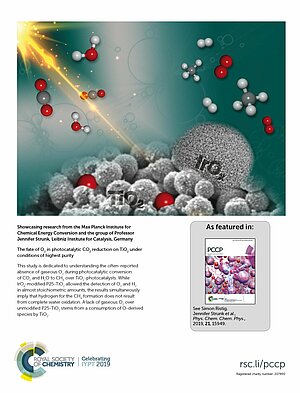During the last decades photocatalytic CO2 reduction has attracted lots of attention as a potential approach in the investigation of alternative renewable energy sources and solutions for the increasing CO2 emissions.
One major issue in fundamental studies on one of the most famous reactions - the gas-phase photocatalytic CO2 reduction over TiO2 catalysts utilizing H2O splitting as hydrogen source - is that often no oxygen can be found among the products in the gas phase or it is not included in the analysis, although the reduction of carbon dioxide with water to methan presupposes oxygen liberation.
To clear up the absence of gaseous O2, Simon Ristig (Research group leader in Robert Schlögl's department) and Jennifer Strunk (Leibniz Institute for Catalysis) and their team modified P25-TiO2 with IrOx, a well-known water oxidation catalyst, which allowed the group to observe gaseous O2 and H2 in almost stoichiometric amounts from photocatalytic water splitting. The study revealed that the conversion of CO2 to CH4 was completely inhibited as long as the water oxidation reaction proceeded, likely due to competition for charge carriers by H2 formation and the backward reaction of CO2 reduction. Furthermore, the team found that the O2 evolution started with a significant delay in comparison to H2, indicating that a certain amount of O2 was consumed under the applied reaction conditions. A quantification showed it to be in the same order of magnitude as the oxygen which is missing as a byproduct in photocatalytic CO2 conversion on bare P25-TiO2.
A detailed interpretation of the results in the context of the general understanding of the photocatalytic CO2 reduction with H2O on TiO2 allows the hypothesis that H2O oxidation might actually not be the hydrogen source for C-H bond formation in CO2 reduction and that the photocatalyst itself could be responsible for the absence of oxygen, only enabling the formation of CH4 as long as it can consume oxygen and thus preventing an inhibiting effect of O2 and O-derived species. This would imply that the photocatalytic gas-phase CO2 reduction with H2O over P25-TiO2 is not based on a true catalytic cycle.
The results of this study were recently published in the journal PCCP and also featured as a back cover.
Publication: Martin Dilla, Alina Jakubowski, Simon Ristig, Jennifer Strunk, Robert Schlögl (2019). The fate of O2 in photocatalytic CO2 reduction on TiO2 under conditions of highest purity
Phys.Chem.Chem.Phys.,2019,21, 15949-1595, DOI: 10.1039/C8CP07765G

